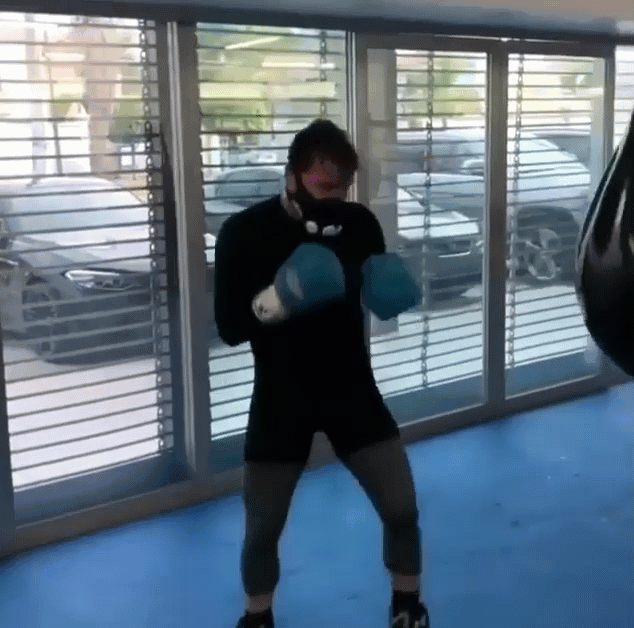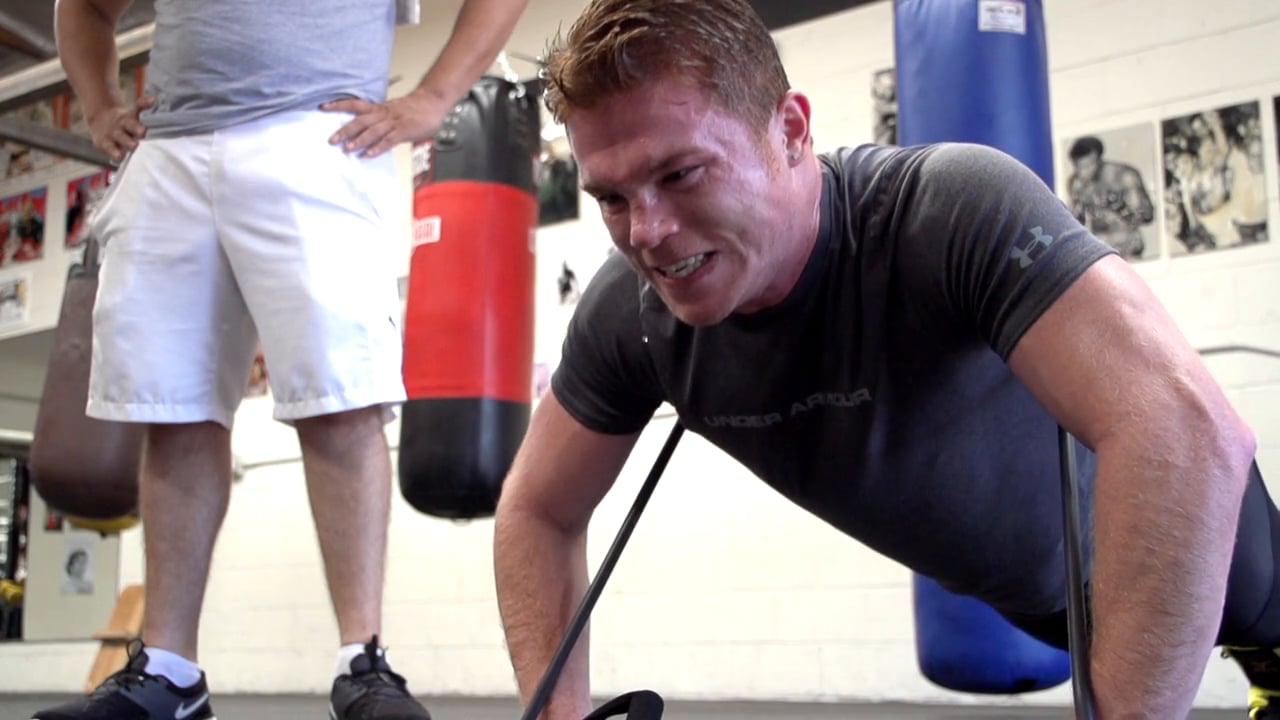After fading in the championship rounds of his duel with Gennady Golovkin, Saul “Canelo” Alvarez was accused of having a conditioning problem.
And judging by Saul’s latest training videos, which features altitude mask training of questionable validity, he may be buying into it himself:
 Why is an elite athlete fading? And why is GGG, an opponent 8 years his senior, outlasting him down the stretch?
Why is an elite athlete fading? And why is GGG, an opponent 8 years his senior, outlasting him down the stretch?
Is the “Canelo Alvarez conditioning problem” real? Or is it all in his head?
Today, we evaluate the apparent Canelo Alvarez conditioning problem. You’ll learn why Canelo gasses out in his fights, how it could all be corrected with a single strategic adjustment, and what makes his empty gas tank so impressive to boxing legend Bernard Hopkins.
And we want to know your thoughts! Join the discussion on our Facebook page.
Hopkins on the Mental Side of the “Canelo Alvarez Conditioning Problem”
“Conditioning [issues] don’t always have to be that your cardio is not up to par. It could be mental; it could be the wrong foods, the wrong reaction… anything,” Bernard Hopkins told FightHype when asked about the apparent “Canelo Alvarez conditioning problem.”
Is the “Canelo Alvarez conditioning problem” all in his head? And what does Hopkins mean when he says it could be that he’s having the wrong reaction on fight night?
Great fighters are not only more efficient with their movements; they also make smarter choices than their opponents, so they don’t have to spend extra energy correcting their mistakes. This means the skilled fighter’s cardio advantage is twofold: micro (technical efficiency) and macro (efficient decision-making) – unconscious and conscious.
“Decision-making” is a broad term, and you certainly can’t say Canelo is a poor decision-maker. Just look at his resume: aside from a controversial draw to GGG, another early in his 52-fight career, and one loss to The Best Ever, his style of training and fighting has worked flawlessly. In fact, we studied Canelo’s sublime decision-making in our technical guides to feinting and “aiming to miss,” as well as our debut boxing technique podcast.
But for all his greatness, Canelo chooses to get tired in every single fight. This one decision affects everything he does in the ring, causing him to fade in the “championship rounds,” and no amount of cardio training will help.
The “Canelo Alvarez conditioning problem” is a misnomer, and it boils down to this: Canelo is a “sprinter.” And in every single fight, Canelo Alvarez is looking to go out and do damage with explosive power punches. In this way, he’s similar to Mike Tyson – “sprinters” with killer instinct – though Canelo’s counter-punching style is quite unlike Mike’s relentless peek-a-boo pressure.
When Canelo tries to apply this “sprinting” style for 12 rounds, one of two things happen: either he knocks his opponent out, or he gets tired down the stretch.
But that’s not a knock on Canelo; getting tired is as much a part of boxing as punching. And that’s why it’s so important to develop your recovery, which Canelo has certainly done in the gym and out on the road. But even elite athletes can’t recover enough to maintain consistent, full-power punching output for 36 minutes. The glycolytic system can’t handle it.
Next time you work the heavy bag, try to fight like Canelo for 12 rounds. Keep your technique in mind, and mix in footwork, head movement, feints, and delay tactics appropriately when you need to recover. But make everything SHARP. Approach every movement as a microsprint. Explode into slips, bobs, and weaves. Use juddering pump-fakes and flashy feints. And when it’s time to punch, really go for it, ripping your whole body into every shot.
After a round or two, you’ll see how exhausting this is. After four or five, you’ll probably be on the floor. Explosive energy isn’t sustainable for a 12-round workout, so it’s certainly not happening in a 12-round fight at the highest level.
To get around this athletic reality, pros space out their sprints. They feint, create space (or take it away), and otherwise find ways to slow things down. And some fighters don’t sprint at all. They get into a “jogging” rhythm.
But Canelo is a young, hungry sprinter who’s chock-full of killer instinct. He’s an explosive counter-punching trying to inflict damage at all times. And that’s why the people love him.
“Problem” versus “Pros and Cons”
Canelo’s decision to “sprint” through fights with full-power punches and explosive movements definitely gasses him out.
But don’t frame Canelo’s decision to fight this way as a “conditioning problem.” If conditioning is your only valuation criteria, then Canelo’s problem is strategic. His energy systems are highly trained – he’s just choosing a fighting style that runs him into the ground eventually.But you need to look at the whole picture. There are pros and cons to Canelo’s style (or any other) that need to be understood. Canelo knows what he’s giving up and what he’s gaining by fighting the way he does.Incidentally, this is the essence of boxing film study and the real “secret” to mastery. As we explain in our film study article:
”There are best practices in boxing. Some techniques land at a much higher percentage and generally keep you safer than others, and these have become the core fundamentals of the sweet science. But while mastering these core fundamentals is essential, limiting yourself to the”textbook” stunts your growth and makes you predictable. Knowing when to bend and break the rules is the sign of a true master in anything, and you only reach that level once you expand your vision of what’s possible in the ring. So rather than labeling any technique as inherently good or bad, try to identify the pros and cons.”
The Beauty Behind the “Canelo Alvarez Conditioning Problem”
As Hopkins goes on to say in his FightHype interview, Canelo getting tired should not be seen as a weakness or a failure on his part or that of his team. Getting tired is part of boxing, after all, especially when you choose to throw your punches with such bad intentions.
On the contrary, Canelo gassing out revealed something even more impressive about the young Mexican icon’s warrior mindset and boxing IQ.
“Canelo understands that you don’t fight when you’re tired,” Hopkins says. “But you don’t quit either. See, you gather yourself. You play chess.”
Boxing isn’t about who finishes the fight the least tired. Canelo gets in the ring and he gets tired, but he still gets it done against the best in the world. Even with boxing’s scariest punchers bearing down on him, he refuses to let himself be drowned by pressure and pain and self-doubt. And that’s why the Canelo Alvarez conditioning problem is bullshit.
When Canelo got tired against GGG, Hopkins says, we had the honour of “watching Canelo find his way.”
He had one hell of a decision to make, and he made a beautiful choice.
Teddy Atlas writes about a similar concept in Atlas: From the Streets to the Ring, which he calls knowing the difference between the truth and the lie.
Let us leave you with a bit of Teddy’s wisdom:
“At a certain point, if he’s going to get to the top of the boxing profession, a fighter has to learn the difference between the truth and a lie. The lie is thinking that submission is an acceptable option. The truth is that if you give up, afterward you’ll realize that any of those punches that you thought you couldn’t deal with, or those rough moments that you didn’t think you could make it through, were just moments. Enduring them is not nearly as tough as having to deal with the next day and the next month and the next year, knowing that you quit, that you failed, that you submitted. It’s a trainer’s job to make a fighter understand that difference, that the parts of a fight that are urgent last only seconds; seconds during which you have to stave off the convenient excuse – “I’m too tired” or “I hurt too much” or “I can’t do this” or even simply “I’m not going to deal with this.” Sometimes it just comes down to not floating – just being there and understanding that if you give in, you’ll hurt more tomorrow. Maybe there is no more important lesson to learn from boxing than that” (Atlas 82).
Works Cited
Atlas, Teddy. Atlas: From the Streets to the Ring. HarperCollins, 2006.
